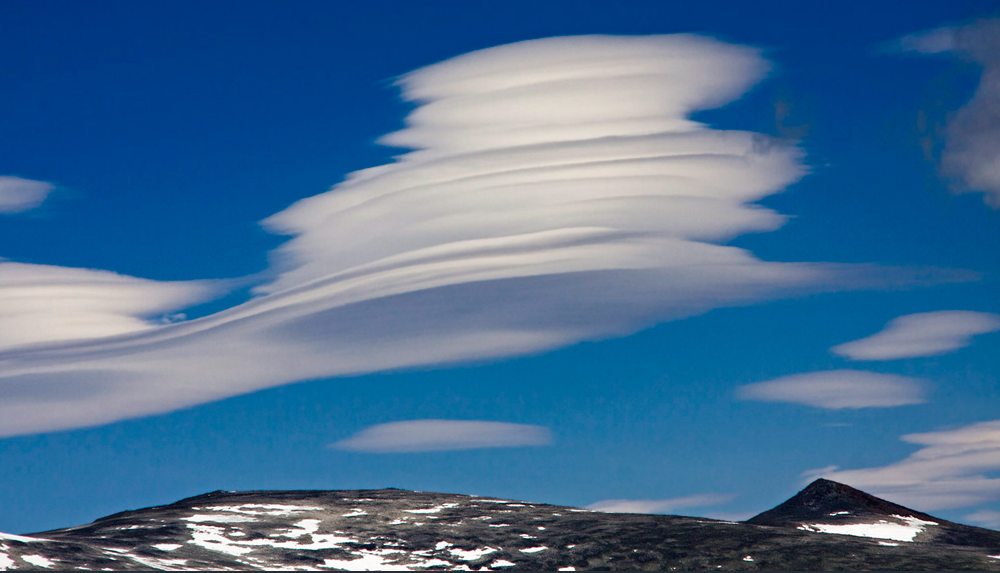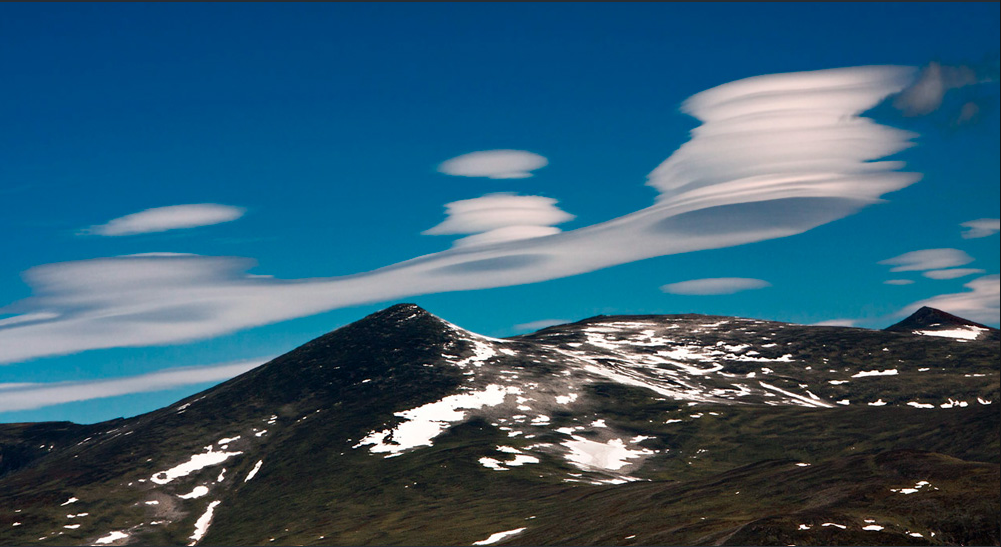Lenticular Clouds, Norway
Lenticular Clouds: Nature's Spectacular Atmospheric Phenomenon
Lenticular clouds, also known as wave clouds, are a mesmerizing atmospheric phenomenon that often graces the skies of Norway. These unique cloud formations are typically found downwind of mountains, where atmospheric waves create the perfect conditions for their formation. While lenticular clouds may appear serene and motionless, they are actually quite dynamic, with air rushing across them and the droplets that compose them existing for only a fleeting moment.
The Formation of Lenticular Clouds
Lenticular clouds owe their existence to the rising and falling of air pockets within atmospheric waves. As an air pocket rises, it expands and cools. If the temperature and humidity are just right, some of the water vapor within the pocket condenses, forming a mist or cloud. This condensation occurs as the air pocket ascends. Conversely, as the pocket descends, it contracts and heats up, causing the droplets within the cloud to evaporate. The layers of a lenticular cloud represent the upper parts of specific atmospheric waves where this constant process of condensation and evaporation takes place.
The Beauty of Atmospheric Optics
Atmospheric optics is a fascinating field that explores the interaction of light with various atmospheric phenomena. Lenticular clouds, particularly when they are thin and composed of similar-sized droplets, exhibit a captivating display of vivid iridescent colors. When sunlight passes through these clouds, the droplets diffract the light, creating a stunning visual spectacle. The diffraction of light by the droplets gives rise to the iridescent colors, adding an ethereal touch to the already awe-inspiring lenticular cloud formations.
Exploring Lenticular Clouds in Norway
Norway's picturesque landscapes provide a breathtaking backdrop for observing lenticular clouds in all their glory. The country's mountainous terrain and coastal regions create the ideal conditions for the formation of these captivating cloud formations. Whether it's the majestic peaks of the Scandinavian mountains or the tranquil fjords, Norway offers countless vantage points to witness the enchanting dance of lenticular clouds in the sky.
The Fascination with Lenticular Clouds
Lenticular clouds have long fascinated scientists, photographers, and nature enthusiasts alike. Their unique shape, resembling flying saucers or hovering discs, has sparked countless imaginations and inspired numerous artistic interpretations. These ethereal formations have even been associated with UFO sightings due to their otherworldly appearance. However, it's important to note that lenticular clouds are purely a natural phenomenon and have no extraterrestrial origins.
Capturing the Beauty: Photography Tips
For photographers seeking to capture the beauty of lenticular clouds in Norway, here are a few tips to enhance your chances of success:
- Choose locations with unobstructed views of the sky, such as mountaintops or open fields.
- Plan your shoot during sunrise or sunset for the best lighting conditions and dramatic colors.
- Experiment with different camera angles and compositions to create visually striking images.
- Consider using a polarizing filter to reduce glare and enhance the contrast between the clouds and the surrounding sky.
- Be patient and observant, as lenticular clouds can change shape and position rapidly, offering unique photo opportunities.
Lenticular Clouds: A Window into Atmospheric Dynamics
While lenticular clouds are undeniably beautiful, they also provide valuable insights into atmospheric dynamics. The presence of these cloud formations indicates the presence of atmospheric waves and the complex interplay between rising and falling air pockets. By studying lenticular clouds, scientists can gain a deeper understanding of how air masses move and interact within the Earth's atmosphere.
Beyond Norway: Global Occurrence of Lenticular Clouds
Although lenticular clouds are frequently associated with Norway's scenic landscapes, they can be observed in various parts of the world. Similar atmospheric conditions near mountain ranges and other topographical features create favorable environments for the formation of these captivating cloud formations. From the United States to New Zealand, lenticular clouds have been spotted in diverse locations, showcasing the universal beauty of this atmospheric phenomenon.
The Transient Nature of Lenticular Clouds
One intriguing aspect of lenticular clouds is their transient nature. Due to the constant rising and falling of air pockets within atmospheric waves, these clouds exist for only brief moments in time. The delicate balance of temperature, humidity, and air movement required for their formation makes lenticular clouds a fleeting spectacle to behold. As such, witnessing these ephemeral creations is a truly special experience that reminds us of the ever-changing nature of our atmosphere.
Conclusion
Lenticular clouds, with their mesmerizing shapes and vibrant colors, are a testament to the wonders of atmospheric optics. Found in the skies above Norway and various other locations worldwide, these ethereal formations offer a glimpse into the dynamic nature of our atmosphere. Whether you're an avid photographer, a curious scientist, or simply an appreciator of natural beauty, lenticular clouds are a captivating sight that never fails to inspire awe and wonder. So, next time you find yourself gazing at the sky, keep an eye out for these enchanting cloud formations and let their transient beauty leave an indelible impression on your soul.

Altocumulus Lenticularis over Norway imaged by Marcin Grzybowski (photography site) of Poland. ©Marcin Grzybowski, shown with permission.


Lenticular clouds form where there are atmospheric waves, usually downwind of mountains.
They are very dynamic objects. Whilst they appear stationary and peaceful, air is rushing across them and the droplets that comprise them live for no more than a few seconds.
Air in atmospheric waves rises and falls. As an air pocket rises it expands and cools. If its temperature and humidity are right some of its water vapour condenses to form a mist or cloud. This happens as the air pocket is rising. As the pocket falls again it contracts and heats and its droplets evaporate. The layers of a lenticular cloud represent the upper parts of particular atmospheric waves where condensation and evaporation are occurring.
Atmospheric optics? Wherever small droplets form quickly and are �young� they have similar sizes. When these clouds are thin (not as here!) their droplets diffract sunlight to give vivid iridescent colours.
Note: this article has been automatically converted from the old site and may not appear as intended. You can find the original article here.
Reference Atmospheric Optics
If you use any of the definitions, information, or data presented on Atmospheric Optics, please copy the link or reference below to properly credit us as the reference source. Thank you!
-
<a href="https://atoptics.co.uk/blog/lenticular-clouds-norway/">Lenticular Clouds, Norway</a>
-
"Lenticular Clouds, Norway". Atmospheric Optics. Accessed on November 26, 2024. https://atoptics.co.uk/blog/lenticular-clouds-norway/.
-
"Lenticular Clouds, Norway". Atmospheric Optics, https://atoptics.co.uk/blog/lenticular-clouds-norway/. Accessed 26 November, 2024
-
Lenticular Clouds, Norway. Atmospheric Optics. Retrieved from https://atoptics.co.uk/blog/lenticular-clouds-norway/.